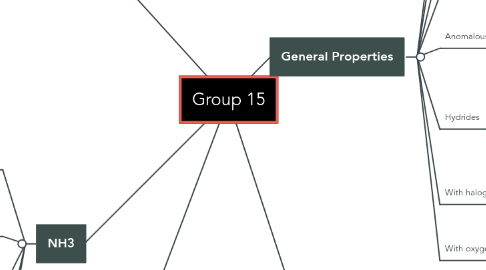
1. Phosphorous
1.1. Allotropes
1.1.1. White
1.1.1.1. tetrahedral P4 units, greater angle strain, more reactive
1.1.2. Red
1.1.2.1. polymeric P4 structure, high bond dissociation enthalpy, less reactive
1.2. Phosphine
1.2.1. Preparation P4 + 3NaOH + 3H2O = 3NaH2PO2 + PH3
1.2.2. Halo acids PH3 + HCl = PH4Cl
1.3. PCl3
1.3.1. P4 + 6Cl2 = 4PCl3
1.3.2. P4 + 8SOCl2 = 4PCl3 +4SO2 +
1.4. PCl5
1.4.1. PCl3 + Cl2 = PCl5
1.5. Oxoacids
2. NH3
2.1. Haber's process N2 + 3H2 = 2NH3
2.1.1. 450-500 celsius temp
2.1.2. 200 to 900 atm
2.1.3. finely divided Fe-catalyst, Mo - promoter
2.2. Catalytic oxidation - (Pt, 800 degree Celsius) 4NH3 + 5O2 = 4NO + 6H2O
2.3. With Chlorine
2.3.1. Excess NH3 with Cl2 8NH3 + 3Cl2 = 6NH4Cl + N2
2.3.2. Excess chlorine with NH3 NH3 + 3Cl2 = NCl3 + 3HCl
2.4. With CuO
2.4.1. 3CuO + 2NH3 = 3Cu + N2 + 3H2O
2.5. Complex formation
2.5.1. CuSO4 + 4NH4OH = Cu(NH3)4SO4 + 4H2O
3. HNO3
3.1. Lab - NaNO3 + conc. H2SO4 = NaHSO4 + HNO3
3.2. Catalytic oxidation of NH3- (Pt, 800 degree Celsius) 4NH3 + 5O2 = 4NO + 6H2O 2NO + O2 = 2NO2 3NO2 + H2O =2HNO3 + NO
3.3. Properties
3.3.1. 3Cu + 8HNO3 (cold, dil)= 3Cu(NO3)2 + 2NO + 4H2O
3.3.2. Cu + 4HNO3 (hot, conc) = Cu(NO3)2 +2NO2 + 2H2O
3.3.3. C + 4HNO3 = CO2 + 4NO2 + 2H2O
3.3.4. S8 + 48HNO3 = 8H2SO4 + 48NO2 + 16H2O
4. General Properties
4.1. Ionisation energy -High - half filled p-orbitals; decreases top to bottom
4.2. Electron affinity - High, decreases down the group.
4.3. Atomic/ ionic radii - increases down the group. Small increase from As to Bi - imperfect shielding of d and f- electrons.
4.3.1. N - +3, -3, +1, +2, +4
4.3.1.1. No +5 - no d- orbitals
4.4. Oxidation states
4.4.1. -3, +3, +5
4.4.1.1. Stability of +3 increases down the gp - inert pair effect
4.5. Anomalous properties of N
4.5.1. Unreactive at low temp
4.5.1.1. high bond dissociation enthalpy - triple bond between N atoms
4.5.1.2. p3 configuration - half filled - extra stability
4.6. Hydrides
4.6.1. BP - increases down the group
4.6.2. BP of NH3 >PH3 - H- bonding in NH3
4.6.3. Basic character - decreases down the group
4.6.3.1. Size increases - electron density on the atom decreases.
4.7. With halogens -
4.7.1. MX3
4.7.1.1. SP3, Pyramidal
4.7.2. MX5
4.7.2.1. sp3d2, triagonal bipyramidal
4.8. With oxygen
4.8.1. M2O3, M2O5
4.8.2. N- N2O, NO, NO2, N2O3, N2O5
5. Nitrogen
5.1. Preparation
5.1.1. Ba(N3)2 on heating Ba and 3N2
5.1.2. (NH4)2Cr2O7 on heating N2, Cr2O3, 4H2O
5.2. Properties
5.2.1. with metals - nitride
5.2.1.1. 3Mg + N2 = Mg3N2
5.2.1.2. 3Ca + N2 = Ca3N2
5.2.1.3. 2Al + N2 = 2AlN
5.2.2. With hydrogen - ammonia
5.2.3. Oxygen - oxides
5.2.3.1. N2+O2= 2NO
5.2.3.1.1. lightning/ 2000 degree celsius
5.2.3.2. N2O
5.2.3.2.1. NH4NO3 = N2O + 2H2O
5.2.3.3. N2O3
5.2.3.3.1. 2NO + N2O4 (250K)= 2N2O3
5.2.3.4. NO2
5.2.3.4.1. 2Pb(NO3)2 = 2PbO + 4NO2 + O2
5.2.3.5. N2O5
5.2.3.5.1. 4HNO3 + P4O10 = 4HPO3 + 2N2O5
